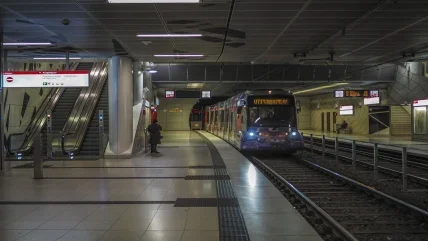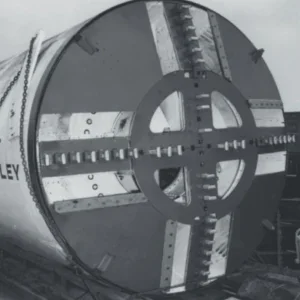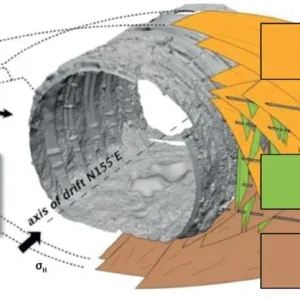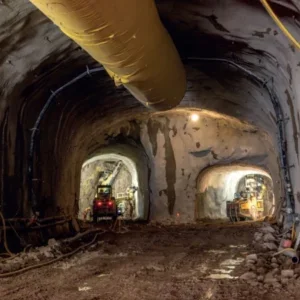
Bob ibell moved from nuclear construction in 1976 to a metro tunnel being driven through coal measures, keenly aware that he knew very little about tunnelling. He is indebted to Dai Heycock and Maurice Gooderham who took up his education at the Gateshead Tunnel project, with lunch times devoted to instruction in the art of tunnelling, and since then he says he has been learning every day.
For Ibell and for the purposes of the lecture he defined improvement as:
- Improving efficiency
- Improving safety and welfare
- Improving productivity
- Improving competence With the aim of:
- Lowering costs
- Making better use of resources
- Facilitating more underground Infrastructure
We have, over the last 50 years, seen significant improvements that have allowed us to tunnel safely through ground that we would not have contemplated previously. We have gained understanding of risk, ground behaviour and the use of materials. We have certainly improved capability and safety, but not productivity, efficiency nor cost reduction.
Three important aspects have a significant impact on improvement: collaboration, communication, competence.
Concerns
It is generally assumed that people want to improve in these ways. But there are individuals with concerns. For example: Does improving efficiency mean robots will take over tunnelling? Does lowering costs mean fewer jobs?
Productivity is itself a measure of how many hours of labour are taken to produce an amount of value, so again perhaps fewer jobs.
However, Ibell believes that it is the industry’s responsibility and purpose to achieve the aims listed above, to improve society and provide more underground infrastructure at better value. And perhaps to get a better work-life balance for tunnel engineers.
COLLABORATION
Collaboration has become an overused and abused term. In relation to the tunnelling industry it includes: teamwork, partnering, alliancing, strategic alliances, supply chain partnerships, single teams, integrated teams, early contractor involvement, innovative contractor involvement, and optimised contractor involvement. It is about people coming together to achieve common or complementary goals. These are systems to avoid an adversarial environment; some have succeeded while some have not.
Basic precepts of a collaborative
- Acceptance that the cost of the project is down to the client
- Incentives to manage risk and reduce cost
- Willingness to enter into trusting relationships
- Proficient cost-auditing
- Acceptance of fairness to all contributors: client, consultant, contractor, sub-contractor
The industry could improve dramatically if it focused on performance rather than fighting over prices.
When Ibell began work in 1967, he argues there was a natural collaboration. The engineer and the contractor’s representative were put together and expected to work together, agreement was needed all the time to move forward. In his career, experience and understanding of the other side’s requirements resulted in successful projects, and a lack of this almost always resulted in arguments, decreased progress, increased costs and disputes.
Ending the seventies
At some time in the late 1970s/early 1980s, things started to change. Clients were unwilling to leave important decisions to the engineer.
Perhaps because the engineer was contractually bound to be impartial. The 1980s saw the emergence of the project manager, and management contracting.
Clients reduced their capabilities and employed a project manager who believed he or she knew all about it, creating more interfaces and agendas.
The nineties
The late 1980s and early 1990s in the UK were dominated by the Channel Tunnel. Collaboration was not an issue because it was one team on the British side and work on site centred on performance.
Then came some good thinking on contract form from the west side of the Thames Water ring main project: the Institution of Chemical Engineers Cost Reimbursable, which worked well for some, but not all. Also, there were the beginnings of a collaborative approach through the bringing together of prospective contractors to assist in machine selection, and matching machines and linings. The client even took a share in the precast facility.
The Jubilee Line Extension in the late 1990s used a modified FIDIC contract and on-demand performance bonds, and a payment system based on milestones – which were described on the project as millstones because of the grief they gave both sides when things did not run as expected but there was a need for cash to keep flowing.
Successful delivery was again about people and relationships on a very difficult project.
But the perception that all was not well in the construction industry had been growing through the 1990s and clients were using aggressive contracts to offload risk.
The government was looking for answers and commissioned Sir Michael Latham’s 1994 review of procurement and contractual agreements (known as ‘Constructing the Team’). Quite a brave report, it said “the issues of the review provoke profound disagreement throughout the construction process” and described its own recommendations as radical. Key points from the Latham review were:
- Better performance is required
- This requires teamwork above all
- Implementation begins with clients
- Government should commit itself to being a best practice Client
- There should be construction clients’ forum of government and private clients
- All should start to use the NEC form of contract (although this is not yet right)
- Tenders should be evaluated on quality as well as price The Latham review said construction industry participants have three options regarding the report:
- They can refuse to have anything to do with them. That would be a pity. The problems would remain, but the goodwill to tackle them, which has been growing dramatically, would be lost
- They can pick out the sections which suit them and reject the rest. If everyone does that, nothing will happen
- Or, hopefully, they can try to make the package work, through the implementation structures which the report recommends. They can set about Constructing the Team.
- In 1998, the Eagan Report, ‘Rethinking Construction’ identified five key drivers of change:
- Committed leadership
- A focus on the customer
- Integrated processes and teams
- A quality-driven agenda
- Commitment to people
In particular, it took aim at clients particularly public sector clients, that are undiscriminating and still equate price with cost, selecting designers and contractors almost exclusively on the basis of tendered price.
It concluded that this is widely seen as one of the greatest barriers to improvement and that the industry needed to educate and help its clients to differentiate between best value and lowest price.
The millennium
Then, by the late 1990s, partnering had ‘come of age’. Partnering training was widespread. A number of sub-projects were being developed on a partnering basis, on some fairly major schemes such as: High Speed 1, Cern, Highways Agency jobs and the Ramsgate Port Access Tunnel.
HS1 Section 2 got away in 2001 with three tunnelling contracts and the Stratford Box. This was procured on a very thoughtful basis, time being taken to get target costs which were sensible, and properly allowed for the risks. Good working relationships were built from the outset.
However, late in the procurement process onerous liquidated damages had been introduced. So when there was an in-line delay to the Stratford Box which was needed to get the drives away contractors were more mindful of the risk of damages than making a small gain on acceleration measures.
Collaboration and consultation between the contractors and the project manager produced a proposal based on paying cost plus a fee with a sum of money roughly equal to the contractor’s profit margin as an incentive used up if the contractors between them ran over cost and risk allowances.
The London Tunnels Alliance was born. Four contracting joint ventures and the client, working together on an integrated basis with the project manager to save cost.
Highly successful, low costs, high performance, below budget, ahead of time.
This was however a privately funded project (although government-backed) and Bechtel was part of the client, was the project manager and responsible for the design.
The result was that it little influenced the thinking of our civil servants (DOT) and was not fed into the thinking of other projects; for Network Rail for instance. There were other collaborative projects going on though; the Highways Agency had developed an approach of selecting a number of contractors, via the Capability Assessment Toolkit (CAT), monitoring their improvement process, and then selecting them for bidding for projects based on their CAT scores.
Bidding was on the basis of a quality bid explaining: how the contractor was going to deliver on the HA KPIs, what the evidence was that the approach proposed would be beneficial and how the contactor proposed to improve on his previous performance in this respect.
Projects were let on a D&C basis using a two phase contract. The contractor had to justify its overhead percentage and that of his designer but essentially the HA accepted that the cost was the cost and they could control the design and scope by acceptance or not before proceeding from (Stage1) design development to (Stage 2) construction. Target cost was developed at end of stage 1.
A report later suggested that the Highways Agency was not able to control its budget, this was taken to mean that costs were out of control and so the concept was shelved.
Thameslink 2000 began in 2007, the project used early contractor involvement, paying contractors to come in to develop the design and construction method then sent them away to bid for a different section.
Bidding on the basis of another’s design still ended up with significant cost increases.
In 2010 contractors spent time and money to become accredited under a new British Standard for Collaborative Business Relationships, but according to Ibell found that this changed little.
Crossrail and modern British Tunneling
Then came Crossrail, which began construction in 2002. It was not very collaborative and saw significant contract package cost growth. They used Optimised Contractor involvement but entering into this the contractor was already in a commercial, costed contract and so reacted accordingly in its best interests.
It was too late, ineffective and actually cost the client.
The London Underground stations, Tottenham Court Road, Victoria and Bond Street, despite advice to the contrary, were let on a conventional target cost contract and all experienced significant cost increases.
Innovative Contractor Involvement (ICE) was introduced for Bank Station and LUL believed they had a value for money solution after a great deal of expensive development work. The outcome remains to be seen; rumour has it that the forecast outturn has risen significantly but this will be a demonstration project for the Project 13 approach (a new approach for delivering high-performance infrastructure, currently being worked on by the UK’s Institution for Civil Engineers).
Thames Tideway set out with the clear intention of working collaboratively but did not take the concept beyond a plan for an alliance between the contractors. The project is in progress so not for further comment.
High Speed 2 has opted for early contractor involvement, but Ibell remarks on the development of a large in-house team, which is odd if the project is aiming for integration. It also has a number of pain/gain incentives that could prompt non-collaborative behaviours.
The present day
Ibell looks at 2018 and asks a series of questions, saying he is confused that collaboration has not been fully taken up: “Looking at 2018, have we improved our collaboration over the years? Have we worked together to reduce costs? Do we now know how to set up an integrated team focusing on costs, not targets? Do we have shared common objectives? Are we reducing costs by taking wise decisions?”
The industry has gotten better at budgets, but budgets are for beating, not spending. A percentage of the cost of the project could be saved if collaboration is used. Commercial arguments, legal arguments, dispute meetings, claims preparation are time and cost wasted by the site and the off-site staff.
There are still barriers to collaboration. Possibly the industry is frightened, because collaboration:
- Exposes poor performance
- Is subject to knowledgeable peer pressure
- Highlights inefficiencies
- Works in real figures
- Produces responsibility dilemmas
- Requires good working relationships
- Other reasons for delays in the adoption of a collaborative approach are:
- Old habits, old thinking that procuring a construction project is the same as procuring a car.
- Belief in the myth that clients can off load their risks.
- Belief in the myth that price competitive tendering always reduces costs.
- Procurement people, engineers and managers who cannot think how to compete except on price.
- Lawyers who have to give you negative advice (because that’s how they interpret their job) and tell you to put clauses in a contract “to protect their client”.
- Directors from contractors who have been brought up to be aggressive and fight with the client and client directors who know no other way.
- Client and contractor personnel who always think there is a cheap or cheaper bid to be obtained.
- A real lack of understanding of what infrastructure does cost. There is some way to go, but the reports in the further reading box at the end of this article suggest that good efforts are being made.
COMMUNICATION
Included in ‘communication’ is anything verbal, written or through digital technology. It is important first and foremost to us all as humans because it is the way we learn, the way we build relationships, how we develop trust and demonstrate openness and understand what is going on around us. It is the tool we use in our personal, social and our working lives and is a vital asset to the development of working relationships.
Clients, consultants and contractors need to be in real communication to understand their individual drivers and objectives, industry bodies need to communicate between themselves, with their members, and government.
Fifty years ago, site work relied on verbal face-to-face communication. Telephones were in the office, maybe one or two, but formal communication was via a triplicate pad. One copy would go to the clerk of works, one would stay in the office and one went to the quantity surveyor.
The progression was then to typewriters, telex, fax and to word processors. Desktop computers arrived in the mid-1990s. Although, says Ibell, in the early days many were not used and were felt to waste time. Secretaries were gradually sacked, and workers began handling their own communications.
Post-2000
After the millennium, we have seen an explosion in means of communication. Mobile phones, texts, tweets, WhatsApp, Snapchat and Skype all added to email.
The conference call replaced the meeting and social media encourages the sharing and recording of anything, which pushes into business.
Data security requirements have also brought bureaucracy and infringement upon personal freedoms.
Ibell suggests that despite awesome means of communication today with bloated inboxes of all varieties, people actually communicate less, or at least less in effective terms, and waste a great deal of time.
He asks: “does a smiley really replace a smile? I believe we will always need innovation in the tools of communication, but communication demands its own special place in human relationships.
“We need to think about and work at effective personal, business and industry communication as we go forward if we are to improve our ourselves and our industry.”
COMPETENCE
There are three areas of interest within ‘competence’ that are addressed: the competence of engineers and technicians; the competence of the workforce; and the levels of competence in place to run projects.
Competence of engineers and technicians
Where tunnelling is concerned we need to look not only at our civil engineers and technicians but also our mechanical engineers, geologists and surveyors. Fifty years ago, competence was understood to be a combination of academic qualifications, practical experience, knowledge and training. In more recent times we came to understand that there were a number of human factors involved.
They were always there and considered by any good manager when assessing competence, but not laid down as criteria. Some general human factors are: awareness of responsibility, rational thinking, communication, collaboration, leadership, resource management, personal responsibility, continuing professional development (CPD) and business awareness. For Ibell, academic qualifications remain the best foundations for a career in engineering, but they might be less important than previously as work roles become more compartmentalised, more focused.
This is also a restriction to gaining the traditional, ‘practical’ site experience which limits their development as an engineer and manager.
Academic qualifications have not changed significantly in the last half century, despite moving with the times and with the development of things such as the degree apprenticeship model. Professional qualifications now include human factors, but have not changed otherwise.
“However, engineering is a very responsible job. Despite any perceived shortcomings an engineering degree or similar technical qualification remains a great introduction to the industry and a basis on which to take responsibility.
“Gaining knowledge is always the challenge and more importantly gaining relevant and useful knowledge when there is so much available. The internet and databases are a great asset and can play a great part in the learning process by providing almost boundless information. We have marvellous tools, but they still need a user, we have always needed the will to go find information.”
Evidence-based decisions are currently being made without the evidence being fully understood by the decision maker. Tunnelling societies such as the British Tunnelling Society and Germany’s Stuva are vital for ensuring that engineers have, or have access to a breadth of knowledge and experience, but engineers must contribute, rather than just attending for networking purposes.
Training can make a real difference, and CPD is heading towards becoming mandatory. It is a useful discipline to reflect on what one learns throughout a career.
Competence of workforce
A core issue for a competent workforce is that everyone wants it, but no one wants to pay for it. A key benefit is health and safety performance.
In the early ‘90s the concept of the NVQs for tunnellers was conceived because there was no recognition of tunnellers’ skills. An Occupational Working Group was set up supported by the CITB, the Tunnelling Sub Committee of the FCEC and other industry bodies including the unions.
NVQs were prepared, but there was little take up of these qualifications, partly because the shape of the industry was changing. Large contractors were moving towards sub-contracted labour, there was no continuity of work and perhaps most importantly there seemed to be no benefit in it for employer or tunneller.
The CSCS card came into existence against the wishes of the Tunnelling Occupational Working group and the BTS because it placed no emphasis on assessment or qualification and negated the push towards NVQs.
The concept of a safety passport was also introduced where tunnellers were trained and assessed in underground safety before going underground and registered for their NVQs.
Recognising the need for an industry body as distinct from a learned society a group of contractors got together and, assisted by the CITB, formed Tunnelskills, a National Specialist Training Forum.
Tunnelskills then worked with CITB and others to make the NVQs more useful and manageable, started thinking about apprenticeships and set up a full Safety Passport scheme.
Instead of this being taken forward it was killed off by Crossrail because being an industry scheme it was not recognised for grants. The bones of it were grabbed and watered down. The Tunnel Safety Card was introduced and subsequently found inadequate by the HSE and little progress was made on NVQs despite requirements in the contracts. The industry was almost back where it started.
Tunnelskills did not give up and go away. It kept developing the qualifications and contributed as it could to the industry. Post-Crossrail it has, with CITB, produced the Tunnel Safety Training Scheme (TSTS) and been instrumental in developing the Trail Blazer Apprenticeship in Tunnelling Operations.
Tunnelskills is still very active and going forward today with apprenticeships in the hope the new apprenticeship levy and some political intent will bolster take up. The levy has been introduced because industry was taking little interest in training and development but there is little indication of a push for tunnelling apprentices as distinct from office-based roles.
“The problem remains the industry structure where the main contractors do not employ the operatives and show little interest in the competence of the operatives except where there is a safety risk which could rebound on them.
“What is needed is acceptance by clients, contractors and project mangers that that a competent workforce and investment in the future workforce is a benefit to all,” concludes Ibell.
Competence of managers
Project delivery 50 years ago had a single-point technical and financial responsibility, which rested with the engineer. As projects became larger and contractual arrangements changed, responsibilities were shared out.
There has been the growth of the project manager and the view held by some that a trained project manager can project manage anything.
The industry also faces contractors with a senior manager not technically competent in the works to be constructed and teams pulled together at the last moment before work commences. “I recall one tunnelling project where an argument over support with a resident engineer who was not a tunneller resulted in the contractor shotcreting an advance on a large SCL tunnel only to see it totally collapse minutes later (as the contractor had predicted),” says Ibell. “We seem to have lost the concept of the guiding mind, the person who had a vison for the project; knew the improvements she or he wants to make; and the competence in sufficient areas to understand what has to be done.
“It is unrealistic to insist that everyone has to be competent in everything, but decision makers should have sufficient understanding of evidence and options to enable sound decisions to be taken.
“Occupying the technical high ground is a priority and I would urge BTS and its members to consider again registration of tunnellers, or at least establish a CPD system to protect technical competence standards in our industry.”
CONCLUDING REMARKS
We have been told since the 1990s that the industry needs to change, but to date we have not heeded the warnings. The surprising thing for Ibell is that there are three common themes which flow through all of the reports, and from anecdote:
- Work more collaboratively
- Improve communication and performance
- Enhance competence
“I do believe that once again we are at a crossroads. We have Brexit on the horizon and we should grab the opportunity it presents: bring the sides of our industry together, change our procurement processes, improve communications, start collaborating for growth, develop objectives shared by all, and to take a best for UK approach with regards to taxes, technology and skills development.
“There is a brave new world out there. It is not just me saying this. Project 13 gives us a good framework, let’s get to the nit-picking detail wherein lies success or failure.
“Project 13 has the great advantage of being driven by clients who as we know dictate the response of their supply chain by the rules they set.”
Ibell concludes with the following suggested actions:
- Get rid of the price competition concept
- Open up communications
- Become collaborative
- Set up frameworks and establish longer-term relationships
- Encourage those contractors who want to come to the party and support the UK industry as well as their shareholders.







